FÉILE CHULTÚIR CHIARRAÍ
Quicklinks :
Féile Chultúir Chiarraí ( Festival of Kerry Culture ) is a week-long series of ‘hands-on’ workshops for Primary School children, from Third to Sixth class. This festival is hosted by Muckross Traditional Farms and takes place in May every year. The staff of Muckross House Research Library work closely with the staff of Muckross Farms in organising and running the event.
This year (2018) Féile Chultúir Chiarraí will run from Monday '30th April' until Friday '4th May'.
-rope.jpg)
|
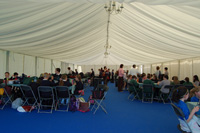 |
All Primary Schools within the county are circularised about the festival in March and booking is on a strictly ‘first come, first served’ basis. Assembly is at 9.45am each morning and sensible shoes and rain gear should be worn. The workshops commenced at 10am sharp and concluded at 2.15pm. Children and Teachers must provide their own lunch, which takes place in the festival marquee, from 11.45am until 12.30pm. The children also usually enjoy visiting the Farm Animal Petting Area during their lunch break.
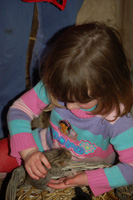 |
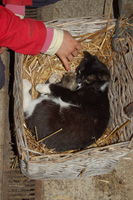 |
The UK-based Heritage Education Trust has awarded Muckross Traditional Farms the Sandford Award for the excellent educational experience provided by Féile Chultúir Chiarraí.
The workshops include the following :
-
 Traditional Music Workshop, presented by the well - known singer/songwriter, Mr Jimmy Crowley.
Traditional Music Workshop, presented by the well - known singer/songwriter, Mr Jimmy Crowley.  The Traditional Irish Dwelling and its’ Furnishings.
The Traditional Irish Dwelling and its’ Furnishings. The Journeyman Carpenter
The Journeyman Carpenter Traditional Bread-making.
Traditional Bread-making. Traditional Butter-making.
Traditional Butter-making.
 Lá Bealtaine ( May Day )
Lá Bealtaine ( May Day )Lá Bealtaine ( May Day ) is traditionally one of the most important days in the Irish calendar. The month of May is, therefore, an appropriate month in which we can celebrate the folklife and culture of Co. Kerry, with ceol agus craic (music and fun).
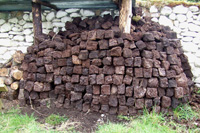 |
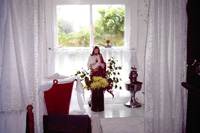 |
May Day marked the first day of summer ( samhradh ) and on the farm it also marked the beginning of the new season of grass ( féar ). The farmer now turned the cattle out into the fields having sheltered and fed them indoors during the colder months of the year. The tilling of the soil to produce crops was generally completed by May Day. At this time also the farmer turned his attention to the bog (portach) and started cutting turf for the long winter months ahead.
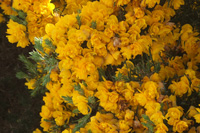 |
On May Eve it was the custom for young children to pick posies of fresh flowers. These were used to decorate the dwelling or were placed at the foot of a holy statue or May altar. The May flowers ( Bláthanna Bealtaine ) in bloom at this time include:
Primrose – Sabhaircín.
Gorse – Aiteann.
Cowslip - Bó Bleachtán.
Marsh Marigold – Riaschbláth.
Meadow buttercup – Fearbán féir.
 Ag Deanamh Ime ( Butter-making )
Ag Deanamh Ime ( Butter-making )There are many May Day customs and beliefs ( crediúintí ) associated with butter and its production. This reflects the important role butter once played in the household economy. Almost anything taken from the dwelling, or from any part of the farm, at dawn on May Day, could be used ‘to steal the butter’ (ime a ghoid). This meant that the victim’s churn would not produce any butter, while the evil-doer would be left with an increased quantity of it.
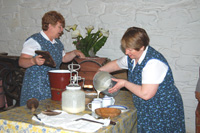 |
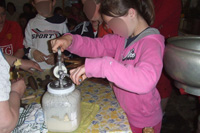 |
No fire was allowed to leave the house on May morning. A man who lit his pipe at the fire had to smoke it before leaving the house. Otherwise it was believed that the luck of the house would be lost and this could affect the butter. No milk utensil was allowed to leave the house either. The farmer might guard his well, the fire might not be lit, and often the cows remained locked in the byre, until the danger had passed.
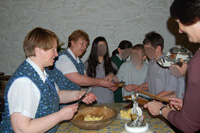 |
 |
Some people avoided churning on May Day. Others did churn but added a pinch of salt ( salann ) or a drop of holy water to protect the butter.
During the churning everybody, young or old (óg nó cnóna), who entered the kitchen or dairy, had to take a turn at the churn. Some people said this was to lessen the labour of churning. Others believed that it helped to protect the butter. If, while churning, butter did not appear within a reasonable amount of time, then it was suspected that an evil spell had been placed on the butter. One way to counteract the spell was to heat an iron tongs in the fire and to plunge it red hot into the churn.
 Ag Deanamh Arán ( Bread-making )
Ag Deanamh Arán ( Bread-making )In some parts of Europe bread was baked occasionally, in large quantities, and stored until required. However, in Ireland, bread was baked fresh every day. In Irish folk belief it was considered unlucky to waste bread or to treat it with anything other than respect.
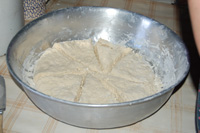 |
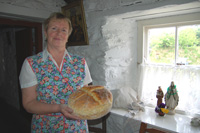 |
Soda bread ( Arán bán ) was traditionally baked in a pot oven over a turf fire and is recognised as one of the finest bread types in the world. The leavening agent in soda bread is bicarbonate of soda, usually helped by sour milk (báinne gear). However bread soda, as a leavening agent did not come into use until the first half of the 19th century. Fresh thick buttermilk (bláthach) was also always used in the baking.
The pot oven ( oighean ) was an excellent baking utensil. The deep flat-bottomed pot had a closely fitted lid on which glowing pieces of turf were placed. This helped to distribute the heat gently and evenly. The lid of the oven could not be lifted until the baking process was complete.
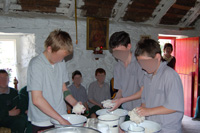 |
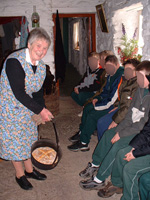 |
At Bealtaine ( May Day ) special cakes were at one time baked and offered to the dead or given to beggars in the name of the dead. On the eve of All Souls’ Night ( 1st November ) it was the custom to leave bread (arán) and water ( uisce ) on the kitchen table at midnight for the return of the dead.
 |
Recipe for Soda Bread
• 5 cups of plain Flour
• Teaspoon of Bread Soda
• Teaspoon of Salt
• One pint of Sour Milk or Buttermilk.
Method:
Put all the ingredients into a basin and make a ‘ well ’ in the centre of the mixture. Pour in the milk and mix with your hands until the mixture forms a soft dough. Knead well and form into a round shape. Cut a cross in the centre of the dough and place it in a warm oven or bastable. Hang the oven over the fire and place red embers from the fire on the lid. Bake for approximately 45 minutes.
 The Journeyman Carpenter
The Journeyman CarpenterThe journeyman carpenter travelled from farm to farm, repairing and fashioning furniture, tools and utensils from locally grown materials. He rarely received money for his work; instead he received his bed and board for the duration of his stay.
In the past, farms were largely self-sufficient and nothing was wasted. If a chair needed to be mended, then the journeyman carpenter sourced the wood on the farm for the repairs.
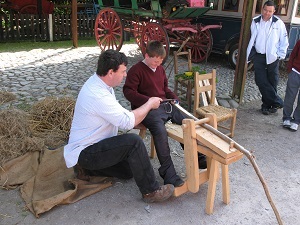 |
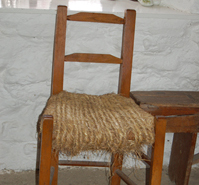 |
Straw, the by-product of the wheat and oat crops was widely used for thatching, animal feeding and for making ropes called sugáin. These durable ropes were used to make chair seats, baskets and nests for fowl. Sugáin ropes were also widely used around the farm.
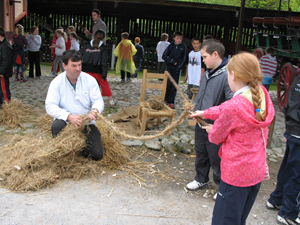 |
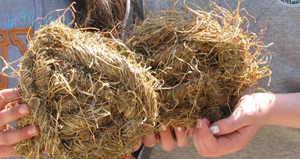 |
Neighbours banded together to help harvest the crops or save the turf. Such a working party was known in Irish as a meitheal. Often children were kept home from school to help with planting the potatoes or harvesting the crops.
 An Teach / An Tigh ( The Dwelling )
An Teach / An Tigh ( The Dwelling )
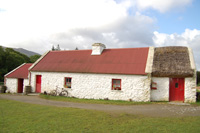 |
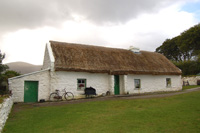 |
The traditional Irish dwelling is rectangular in plan and only one storey in height. The roof (díon) is supported by the solid walls, which are built of stone or tempered earth. The roof is normally steeply pitched. In the past this allowed for the rapid run-of of rainwater as most dwellings had a thatched roof (díon tuí/ceann tuí).
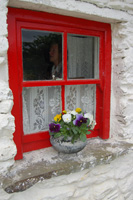
|
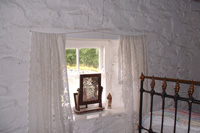
|
Doors and windows ( doirse agus fuinneóga ) are normally located in the long sidewalls. The windows are small in size and splay inwards. From the late 19th century onwards the walls were usually white-washed (aolta), mainly for hygienic purposes.
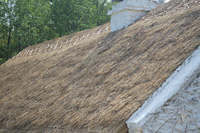 |
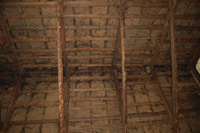 |
Beneath the thatch there was usually a layer of sods or scraws, which had been skimmed off a good thick bog, to form the underthatch. These scraws were normally tied to the roof timbers with straw ropes ( súgáin ). The thatch was pinned to the underthatch with scallops ( scolb ) or spars made from bog-deal, hazel or sallys. Because ceilings were generally inserted into dwellings only in relatively recent times, the underthatch was usually visible directly overhead. You can see the underthatch in place when you visit Kissane’s and Foley’s dwellings on Muckross Traditional Farms.
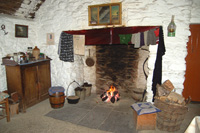 |
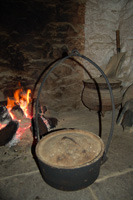 |
Internally the traditional dwelling contained a number of interconnecting rooms without a central hallway or passage. Each room ( seomra ) normally occupied the full width of the dwelling. In Irish folk tradition the kitchen hearth ( tinteán ) was the social centre of the house. A visitor ( cuairteoir ) to the house was usually invited to take a fireside seat. The fire was never allowed to completely die out ( Bhí an tine lasta an t-am ar fad – The fire was lit all the time ). Not only was it an important source of warmth, it was also the only means of cooking food, drying the clothes and boiling water.
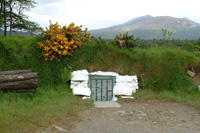 |
 Traditional Songs
Traditional SongsPerhaps you might like to learn the words of the following songs, so you can sing along with Jimmy Crowley when you attend Féile Chultúir Chiarraí

|
THUGAMAR FÉIN AN SAMHRADH LINN
Bábóg na Bealtaine maighdean an tSamhraidh,Suas gach cnoc is síos gach gleann.
Cailíní maiseacha bán-gheala gléasta,
Thugamar féin an Samhradh linn.
Curfá
Samhradh, samhradh bainne na ngamhna,
Thugamar féin an Samhradh linn.
Samhradh buí na neóinín gléigheal
Thugamar féin an Samhradh linn.
Thugamar linn é ón gcoill chraobhaigh
Thugamar féin an Samhradh linn.
Samhradh buí ó luí na gréine,
Thugamar féin an Samhradh linn.
Tá'n fhuiseóg ag seinim 'sag luascadh 'sna
spéarthaibh
Beacha 's cuileóga is blátha ar na crainn
Tá an chuach is na héanlaith ag seimin le pléisiúr
Thugamar féin an Samhradh linn.
Curfá arís
Samhradh, samhradh bainne na ngamhna,
Thugamar féin an Samhradh linn.
Samhradh buí na neóinín gléigheal
Thugamar féin an Samhradh linn.
Curfá arís
FUNGI THE DOLPHIN
In a salty cave beneath the wave,King Neptune made his plan.
He felt so bad as things were bad
For children on dry land,
He called his dolphins around his throne
Awash in the briney sea;
He picked out one with his old pring-pong,
You'll do nicely, said he.
Chorus
They call him Fungi, Fungi,
The darling of the deep
And if you go to Dingle town
You'll see him too.
He's awful funny, funny
The way he turns his tummy
With eyes beguiling bright for me and you.
King Neptune shed a salty tear;
My heart is sad, said he,
For boys and girls around the world
Watch far too much TV,
They never laugh or smile no more
The way they used to do,
So, Fungi, téir go Poll a' Dáimh,
Is cur gliondar ar an slua!
Chorus
Ar maidin álainn, ghrianmhar,
Do shroich sé béal a' chuain,
Bhí bád fen' am ag teach i dtír,
Ba dheas é crut na huaine,
'Sea dúirt an captaen ós ard,
Go dteastaigh uaidh gal:
Mo léir ! Nár ghoid an delphín dubh
An duidín as a bhéal!
Chorus
So, every day on Dingle Bay
The boats to see him go,
Lán de pháistí aeracha
Fé dhraíocht na mara móire,
He sees the children from afar
And winks his eyes with glee;
Ní fada anois go ndéanfar "swish",
Suas leat san aer, Fungi!




